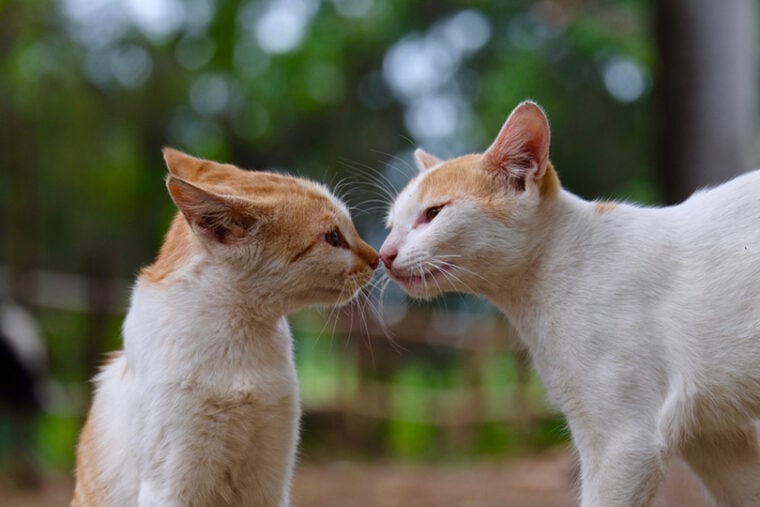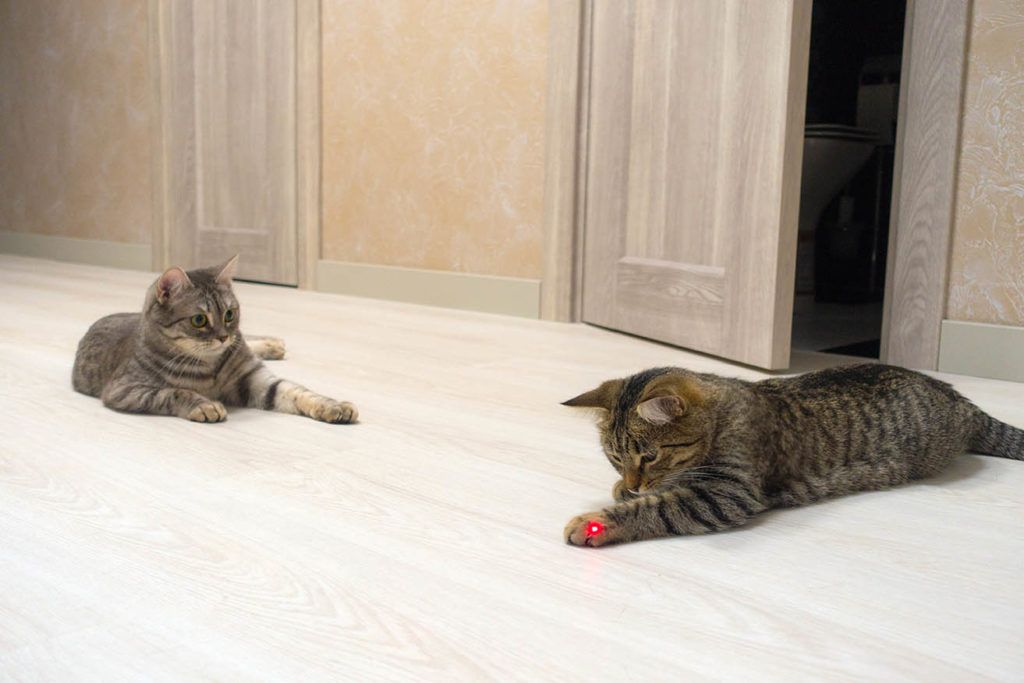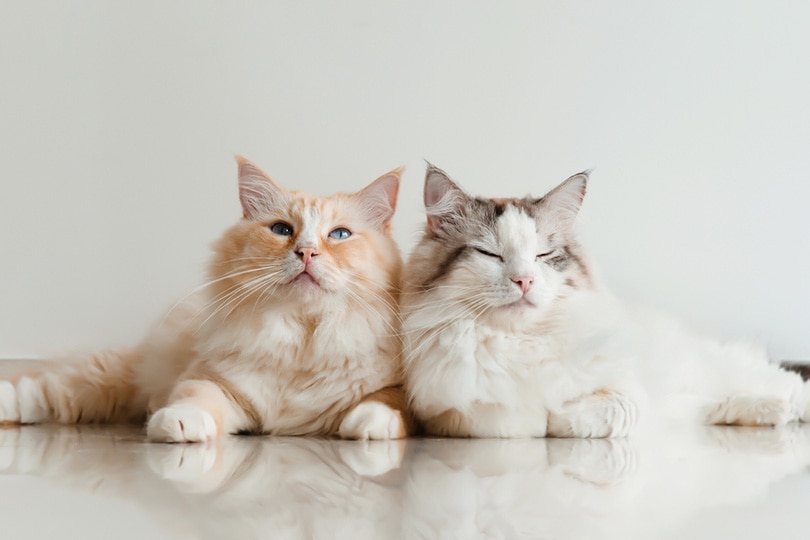
Philosophers have debated the topic of love between animals for centuries. Many would still say it’s hard to define between humans, much less cats. It’s apparent to any pet owner that cats and dogs experience feelings. Scientists have concluded that canines have the emotional maturity of a 2–2.5-year-old child1. They know distress, fear, and even love. However, can cats feel similarly and fall in love with each other?
The short answer is, well, sort of, but not in the way we define it. We have to go back in time to early feline evolution, domestication of wild cats, and modern-day adaptations of the human-cat bond to truly understand the concept.
The Anthropomorphic Trap
If we want to answer this question scientifically, we must dispense with anthropomorphism or the attribution of human characteristics to non-humans. Our pets aren’t little people. They may behave similarly and show feelings, but instincts and evolutionary hardwiring dictate how they act. We’re capable of higher and more complex emotions than our animal companions. That also applies to love.
Our pets can form strong emotional bonds with us. They are affectionate with us and each other. However, they can’t communicate in the same complicated ways we can. Of course, love is a complex emotion when speaking of a bond between two individuals. When we talk about cats loving each other, it’s not in the same context as the relationships we form with other people.

Evolution and Genetics
Both felines and canines produce the so-called love hormone oxytocin. Some research suggests that it may play a role in human-cat bonding2. However, it doesn’t correlate in the same way it does with humans. High levels don’t necessarily mean strong relationships. But cats differ in many ways from both humans and canines. While many canines live in groups, felines are solitary for the most part.
Scientists theorize domestic cats descended from the European Wild Cat (Felis silvestris)3. These animals are solitary and polygynous, with males mating with more than one female. These findings suggest cats can’t love each other, at least not how we may view it. Nonetheless, evolution had another card up its sleeve.
The Influences of Domestication
Scientists estimate that humans domesticated wild cats about 9,500 years ago, coinciding with the development of agriculture in the Fertile Crescent. The puzzling thing about it is that felines didn’t need us, nor did we particularly want them around our settlements. Unlike dogs, they don’t contribute much to our well-being. However, the reason for their domestication goes back to agriculture.
Grains were some of the first foods humans cultivated. And when you plant these crops, you’re putting out the welcome mat for rodents and other pests. It didn’t take long before wild cats started hanging around humans because their crops attracted many of their typical prey. The relationship between felines and people became mutually beneficial.
Fast forward to ancient Egypt, and cats are now cared for and revered. Scientists theorize that the Egyptians may have selectively bred felines to make them more like the lovable pets we know today. That would involve cultivating emotions that were foreign to wild cats. Felines didn’t need to evolve affection for other cohorts because of their solitary lifestyle. Domestication changed that situation.
Even when people started forming communities, cats still stayed with us, presumably because of the easy pickings with rodents following us to villages and towns. That means they had to adapt to being around people and probably each other. These events have had a profound impact on the emotional capacity of cats.

Current Research on Feline Emotional Perceptions
Scientists have long studied the relationship between dogs and humans. Canines don’t hesitate to show their emotions. It’s easy to figure out what’s going on between their ears. Felines have been a different story, not made any easier by the changeable nature of cats. Nevertheless, research has shown that felines are good at reading human emotions and tailoring their behavior accordingly.
These findings suggest cats can comprehend emotions. Another study considered the effect of an owner’s presence on a pet’s response to stress. The researcher observed positive effects showing a higher perceived level of comfort. This experiment demonstrated the bonding between humans and their cats. Clearly, people had a calming influence on their pets, suggesting an emotional attachment.
Other research has focused on the various behavioral traits of cats, which may affect whether they’re capable of falling in love with each other. It doesn’t take a rocket scientist to determine felines have different personalities. Of course, socialization and other environmental factors are strong influences. However, evidence suggests a genetic aspect.
A study conducted by the University of Helsinki found seven distinct behavioral types based on owner input of over 4,300 pets. The findings showed clear differences in cat-to-cat sociability. The Oriental and Burmese scored highest among the breeds, with the Somali and Turkish Van at the bottom of the list.
Breed behavioral variations are well-documented in the scientific literature. Therefore, this data is not surprising. They show a degree of being social, which can, in turn, affect a cat’s ability to love. Scientists know that felines perceive and communicate emotions with other animals. They use visual, olfactory, and auditory means to signal them to one another.
Social Attachments and Bonds
Cats also form social attachments with their owners. Perhaps that is the strongest evidence of cats falling in love. If these animals can form these bonds with a human, it’s not a stretch to surmise they can do the same with one of their own. Another feline has the advantage because it can read the subtle hints that may escape our attention. However, a social bond between two cats is evident if you observe their interactions.
Two bonded cats will do many things together, from grooming to sleeping to playing. They also show a range of emotions. Cats will become angry and fight if the roughhousing goes too far. Likewise, they may begin an afternoon nap with mutual grooming before curling up together. Remember that this behavior is contrary to what wild cats will do. We can conclude it shows a social bond we may call love.

Conclusion
Domestic cats are a far cry from their wild counterparts in many ways. However, the most profound is undoubtedly their sociability. That is a product of domestication and the changes it influences in the animal’s behavior. Pets don’t have to staunchly defend territories to survive. Humans have flipped the switch, making affection between two felines possible.
Featured Image Credit: Sandeep Gore, Shutterstock






